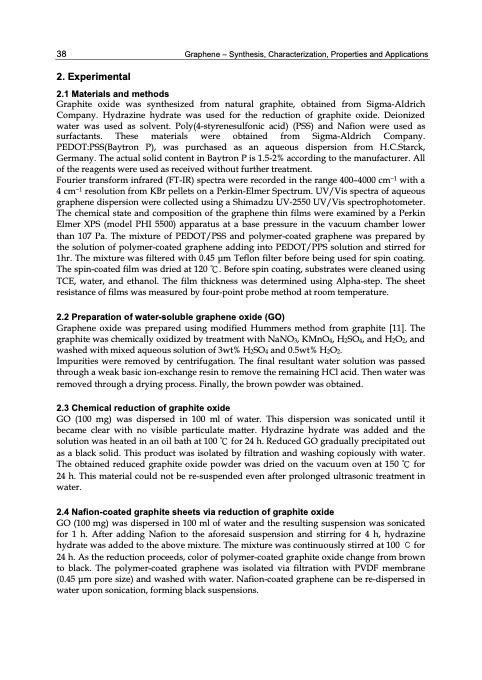
PDF Publication Title:
Text from PDF Page: 048
38 Graphene – Synthesis, Characterization, Properties and Applications 2. Experimental 2.1 Materials and methods Graphite oxide was synthesized from natural graphite, obtained from Sigma-Aldrich Company. Hydrazine hydrate was used for the reduction of graphite oxide. Deionized water was used as solvent. Poly(4-styrenesulfonic acid) (PSS) and Nafion were used as surfactants. These materials were obtained from Sigma-Aldrich Company. PEDOT:PSS(Baytron P), was purchased as an aqueous dispersion from H.C.Starck, Germany. The actual solid content in Baytron P is 1.5-2% according to the manufacturer. All of the reagents were used as received without further treatment. Fourier transform infrared (FT-IR) spectra were recorded in the range 400–4000 cm−1 with a 4 cm−1 resolution from KBr pellets on a Perkin-Elmer Spectrum. UV/Vis spectra of aqueous graphene dispersion were collected using a Shimadzu UV-2550 UV/Vis spectrophotometer. The chemical state and composition of the graphene thin films were examined by a Perkin Elmer XPS (model PHI 5500) apparatus at a base pressure in the vacuum chamber lower than 107 Pa. The mixture of PEDOT/PSS and polymer-coated graphene was prepared by the solution of polymer-coated graphene adding into PEDOT/PPS solution and stirred for 1hr. The mixture was filtered with 0.45 μm Teflon filter before being used for spin coating. The spin-coated film was dried at 120 °C. Before spin coating, substrates were cleaned using TCE, water, and ethanol. The film thickness was determined using Alpha-step. The sheet resistance of films was measured by four-point probe method at room temperature. 2.2 Preparation of water-soluble graphene oxide (GO) Graphene oxide was prepared using modified Hummers method from graphite [11]. The graphite was chemically oxidized by treatment with NaNO3, KMnO4, H2SO4, and H2O2, and washed with mixed aqueous solution of 3wt% H2SO4 and 0.5wt% H2O2. Impurities were removed by centrifugation. The final resultant water solution was passed through a weak basic ion-exchange resin to remove the remaining HCl acid. Then water was removed through a drying process. Finally, the brown powder was obtained. 2.3 Chemical reduction of graphite oxide GO (100 mg) was dispersed in 100 ml of water. This dispersion was sonicated until it became clear with no visible particulate matter. Hydrazine hydrate was added and the solution was heated in an oil bath at 100 °C for 24 h. Reduced GO gradually precipitated out as a black solid. This product was isolated by filtration and washing copiously with water. The obtained reduced graphite oxide powder was dried on the vacuum oven at 150 °C for 24 h. This material could not be re-suspended even after prolonged ultrasonic treatment in water. 2.4 Nafion-coated graphite sheets via reduction of graphite oxide GO (100 mg) was dispersed in 100 ml of water and the resulting suspension was sonicated for 1 h. After adding Nafion to the aforesaid suspension and stirring for 4 h, hydrazine hydrate was added to the above mixture. The mixture was continuously stirred at 100 °C for 24 h. As the reduction proceeds, color of polymer-coated graphite oxide change from brown to black. The polymer-coated graphene was isolated via filtration with PVDF membrane (0.45 μm pore size) and washed with water. Nafion-coated graphene can be re-dispersed in water upon sonication, forming black suspensions.PDF Image | GRAPHENE SYNTHESIS CHARACTERIZATION PROPERTIES

PDF Search Title:
GRAPHENE SYNTHESIS CHARACTERIZATION PROPERTIESOriginal File Name Searched:
Graphene-Synthesis.pdfDIY PDF Search: Google It | Yahoo | Bing
Salgenx Redox Flow Battery Technology: Power up your energy storage game with Salgenx Salt Water Battery. With its advanced technology, the flow battery provides reliable, scalable, and sustainable energy storage for utility-scale projects. Upgrade to a Salgenx flow battery today and take control of your energy future.
| CONTACT TEL: 608-238-6001 Email: greg@infinityturbine.com | RSS | AMP |